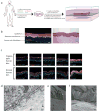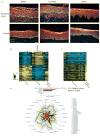Invasive three-dimensional organotypic neoplasia from multiple normal human epithelia
- PMID: 21102459
- PMCID: PMC3586217
- DOI: 10.1038/nm.2265
Invasive three-dimensional organotypic neoplasia from multiple normal human epithelia
Abstract
Refined cancer models are required if researchers are to assess the burgeoning number of potential targets for cancer therapeutics in a clinically relevant context that allows a fast turnaround. Here we use tumor-associated genetic pathways to transform primary human epithelial cells from the epidermis, oropharynx, esophagus and cervix into genetically defined tumors in a human three-dimensional (3D) tissue environment that incorporates cell-populated stroma and intact basement membrane. These engineered organotypic tissues recapitulated natural features of tumor progression, including epithelial invasion through basement membrane, a complex process that is necessary for biological malignancy in 90% of human cancers. Invasion was rapid and was potentiated by stromal cells. Oncogenic signals in 3D tissue, but not 2D culture, resembled gene expression profiles from spontaneous human cancers. We screened 3D organotypic neoplasia with well-characterized signaling pathway inhibitors to distill a clinically faithful cancer gene signature. Multitissue 3D human tissue cancer models may provide an efficient and relevant complement to current approaches to characterizing cancer progression.
Figures




References
-
- Rangarajan A, Hong SJ, Gifford A, Weinberg RA. Species- and cell typespecific requirements for cellular transformation. Cancer Cell. 2004;6:171–183. - PubMed
Publication types
MeSH terms
Substances
Grants and funding
LinkOut - more resources
Full Text Sources
Other Literature Sources
Molecular Biology Databases

